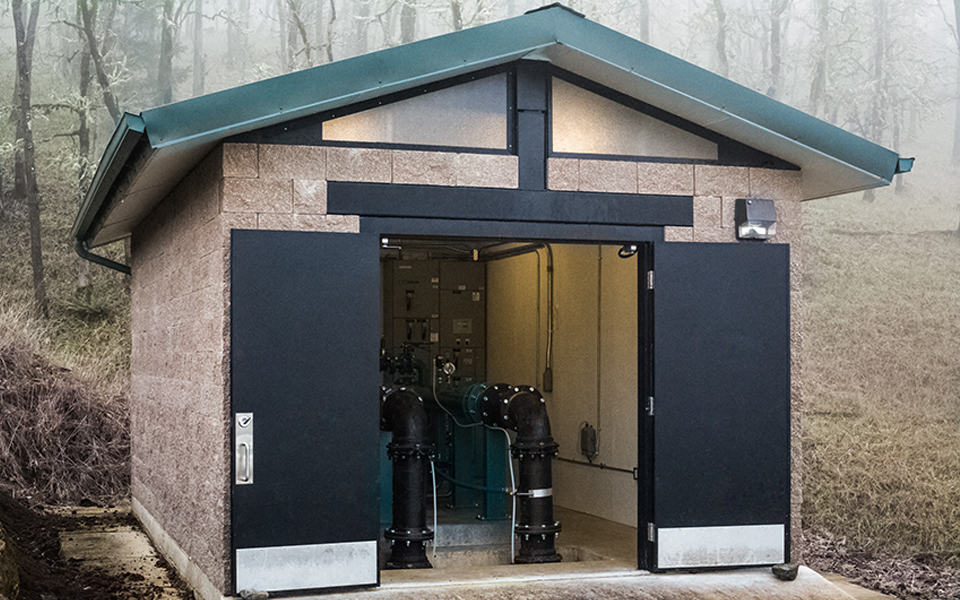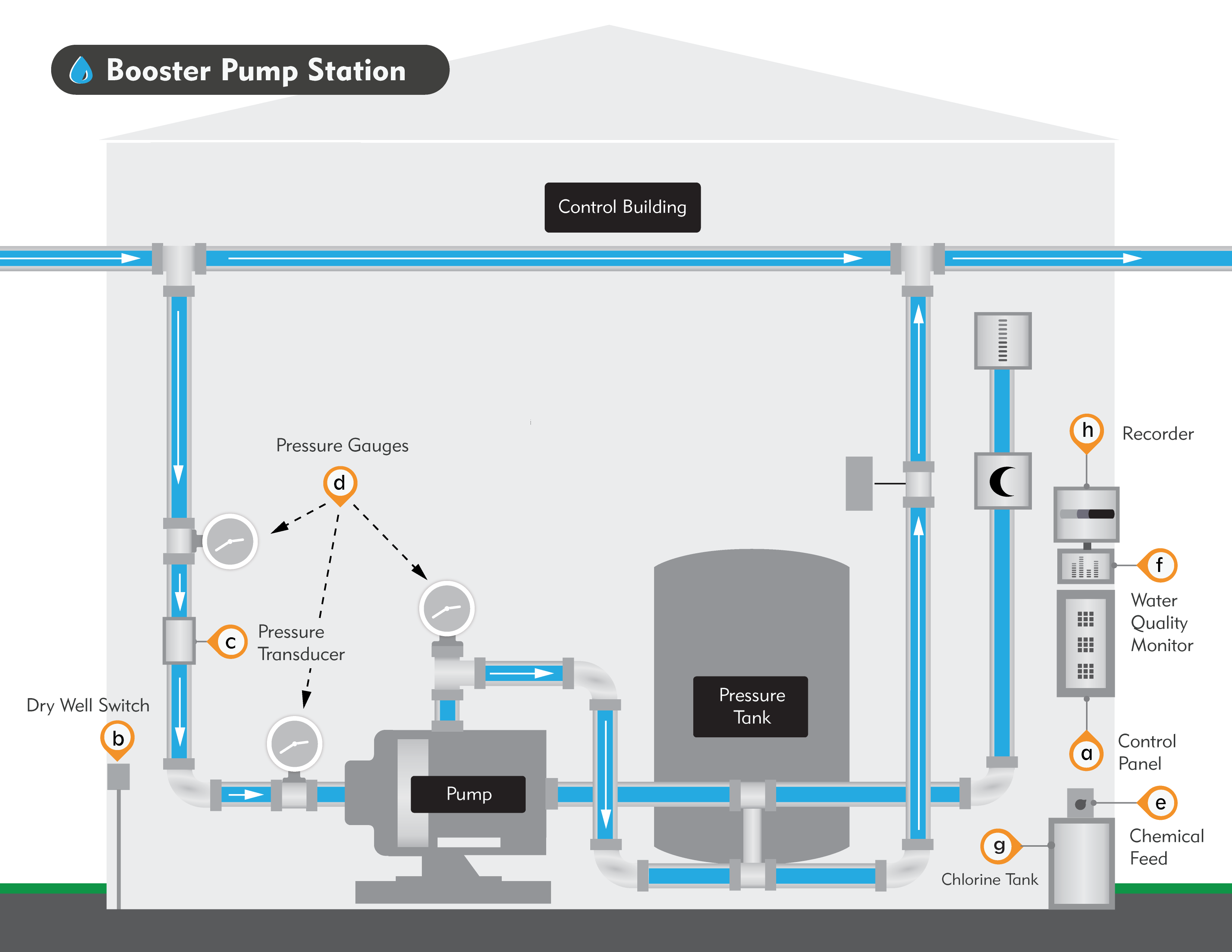We don’t give these small structures much thought but towns and cities in this and other developed countries use the pump stations to move treated potable water from a treatment plant and supply the water grid so that a community has fresh water to be consumed or for firefighting. What is a Water Pump Station?
A Water Pump Station is used for efficient, reliable transportation and distribution of treated drinking water from one site to another also called a pumphouse in situations such as drilled wells they contain pumps and equipment for pumping fluids from one place to another without human input.
In some communities like mine, Water Pump stations dot the landscape, transport and deliver potable drinking water from miles away from the closest city or water treatment facility to new and old developments.
What is a Water Pump Stations
A Water Pump station is used in a water distribution system for efficient and reliable transportation and dissemination of water from one site to another. At the station, the water is pumped into the system and the pressure is modulated based on the slope. This arrangement is made to compensate for the differences in water levels under the influence of gravity.
A pumping station is not always operated at its maximum capacity. The efficiency varies as per the load on the pumping unit, and thus, it is a usual practice to design the station such that some units of the pump can be harnessed at full capacity all the time. This is the reason two or more pumps are installed as standby.
The Types of Valves Used in a Water Pump Station
Sluice valves-A sluice valve or gate valve regulates the flow of water through a pipeline. They are identical to the gate valves used in dams but are comparatively smaller in size.
Check valves-These are also known as non-return valves. These valves prevent water from flowing backward, in the opposite direction. They may be either provided on the pumping set’s delivery side to avoid backflow of pumped or stored water when the pump isn’t functional or to reduce the hammer force on pumps.
Air valves-Air valves are special valves that protect the pipeline from failing by compression caused due to vacuum. They are placed on both sides of the sluice valves, on the summits and the downstream side. The main function of the air valve is to protect the pipe from negative pressure. When the pressure falls below a certain value in the pipe, the valve opens automatically, permitting airflow into the pipe.
Pressure valves-The function of the pressure relief valves is to reduce the water hammer pressure in the pressure pipes. The valve is adjusted in such a way that it opens automatically when the pressure of the pipe exceeds a predetermined value. When the valve is opened, water flows out, and the pressure of the pipes is reduced. Once the pressure is back to normal, the valve shall close automatically.

Adequate water pressure must be maintained for water distribution systems to work properly. Civil engineers leverage gravity to make water distribution systems work, but in areas where the terrain is uneven, booster pumps (and booster stations) are used to help maintain appropriate water pressure levels.
Every home and business relies on having unfettered access to fresh water. Water distribution systems are vital to our daily lives.
We rely on them for sanitation, manufacturing, agriculture, and consumption. Adequate water pressure must be maintained for water distribution systems to work properly.
Civil engineers leverage gravity to make water distribution systems work, but in areas where the terrain is uneven, booster pumps (and booster stations) are used to help maintain appropriate water pressure levels.
What is a Drinking Water Treatment Plant?
Drinking water treatment plants treat raw H2O from ground or surface supplies to be used by their communities using:
Chemical processes-oxidation, coagulation
Physical processes-flocculation, sedimentation, filtration, adsorption
Disinfection with ultraviolet light.
Biological activated carbon (BAC) .……………………………………………………………………………………………………………………………………. Read more
Distribution systems use water pressure is the force at which water travels through a pipe. Water pressure is measured in pounds per square inch (psi). It is normal for water pressure in homes to be between 30 and 80 psi, with anything over 80 psi being a code violation.
Water booster pumps are powerful tools for maintaining consistent pressure. However, overusing booster pumps for water pressure may impact water volume. Increasing the pressure will also increase the flow volume up to a point.
What is a Water Distribution System?
A Water Distribution System is composed of a network of pipes, valves, and pumps through which potable water is moved from a treatment plant to homes, offices, industries, and other consumers it includes storage facilities to store water, meters to measure water use, and hydrants for firefighting .……………………………………………………………. Read more

For every water pressure booster, there’s a level where the increased pressure begins to decrease the amount of water that can flow through the system.
This effect is similar to placing your thumb on a flowing water faucet. You increase the pressure by decreasing the flow rate.
Municipal water systems use sensors to send information about pressure levels as water flows through the pipes.
Having an understanding of where the water pressure is too low can help operators diagnose equipment problems, perform preventative maintenance, or discover locations where supplementary booster pump stations are needed.
There are generally two types of pumps used for potable water pumping station applications: the vertical turbine pump, line shaft, and submersible types, and the centrifugal horizontal or vertical split case pump designed for water-works service.
If the pump station and intake structure are to be located within a surface or underground reservoir, vertical turbine pumps with the column extending down into the reservoir or its suction well will be a logical choice.
Why is a Water Tower so Tall? A Water Tower is a structure supporting a water supply tank built at a height sufficient to pressurize a water system for the distribution of potable H2O & to provide emergency storage for fire protection. Water Towers fill up at night when demand is low & act as a buffer when demand is higher during the day.………………………………………………………………………………………………….. Read more

References: Wastewater Digest-What is a Pump Station

